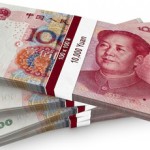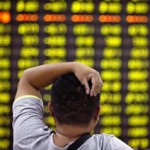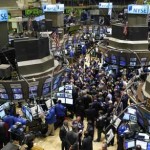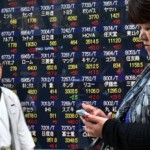Asian stocks steeply lower after China suspends trade early
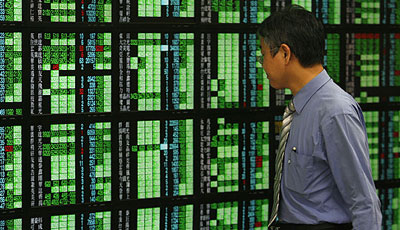
China’s stocks were suspended from all trade on Thursday after the CSI300 tumbled more than 7 percent in early trade, triggering the market’s circuit breaker for a second time this week.
That drop-kicked stock markets across Asia, which were already wallowing after a weaker open amid concerns over China’s swooning currency and economic slowdown as well as falling oil prices.
On the mainland, the Shanghai Composite had tumbled 7.32 percent by at the time of the halt, while the Shenzhen Composite plummeted 8.34 percent. The CSI300, the benchmark index against which China’s new circuit breakers are set, plunged 7.21 percent. If that index rises or falls 5 percent, the market halts all trade for 15 minutes. If it subsequently falls by 7 percent, trading is suspended for the rest of the day.
In total Thursday, China shares only traded around 15 minutes.
Jackson Wong, associate director at Huarong International Securities said he was not surprised by how quickly the first trade halt came. He attributed it to the mentality of Chinese investors. If the index is down “close to 4 percent, the selling price will be heavier,” he told CNBC’s “Asia Squawk Box”. “It hit 5 percent in no time.”
Wong added that officials in China do not appear to have a good grasp of the market, even with the introduction of the circuit breakers, which is waning investor confidence.
“They are not very good at this,” he said, “the 5 and 7 percent [benchmarks to trigger circuit breakers] in China is very, very short.”
In light of the early shutdown, China’s securities regulator also issued new rules to restrict the percentage of shares major shareholders in listed companies can sell every three months, in an attempt to stabilize markets. Shareholders are not allowed to sell more than 1 percent of a company’s share in that period.
The new measures came before the six-month share reduction ban on large shareholders is set to expire Friday.
Before trade, the People’s Bank of China (PBOC) set the yuan midpoint at 6.5646 per dollar, 0.5 percent weaker than Wednesday’s fix, the biggest fall between daily fixings since the devaluation began in mid-August. In spot trade, the dollar-yuan pair was at 6.5906. Expectations the yuan will continue to weaken may spur outflows from China investments.
The worry was further compounded this week after Wednesday’s Caixin non-manufacturing Purchasing Managers’ Index (PMI), a measure of activity for the services sector, showed a slowdown in the pace of growth.
The country is undergoing a structural rebalancing from a manufacturing-oriented to a service-oriented economy, so services sector growth is a key sign of success. The Caixin non-manufacturing PMI for December fell to 50.2, from November’s 51.2. A reading over 50 indicates expansion in activities in the sector.
Toby Lawson, head of global markets in Australia at Societe Generale Newedge, told CNBC’s “The Rundown” the PBOC needs to more consistent in their policy decisions to retain investor confidence.
“The key for investors is to see some transparency, some consistency from the PBOC in terms of its decision-making, its policies in relation to yuan revaluation, fiscal spending and monetary policy,” said Lawson, adding, “If we get consistency, investors feel more confident that Chinese authorities are in control of the declining growth of their economy.”
The record widening of the yuan’s onshore and offshore exchange rates also sparked concerns over Beijing’s undertaking to let the Chinese currency trade more freely.
While Lawson said he expects further devaluation of the onshore yuan, which is more tightly controlled by Beijing, he added that it will be done “in a controlled fashion by the PBOC.”
Australia extended losses Thursday, with the ASX 200 closing down 2.20 percent, with the energy sector taking a 5.29 percent hit by market close. In Japan, the Nikkei 225 slipped more than 400 points to trade 2.23 percent lower, while Korea’s Kospi lost 0.78 percent.
Energy plays Down Under saw steep losses on the back of lower oil prices, with Woodside shedding 5.11 percent and Santos losing 7.41 percent. In Japan, Inpex and Japan Petroleum were down 5.31 and 3.28 percent respectively.
Tensions in the Middle East and a buildup of gasoline inventory stateside sent oil prices tumbling during U.S. trading hours, down over 5 percent.
In Asian trade, the West Texas Intermediate (WTI) crude futures were down 2.21 percent, at $33.22 a barrel, lowest since March 2003. The global benchmark, Brent crude, was down 2.34 percent at $33.43 a barrel, down to a 12-year low.
Resources producers in Australia closed lower, with Rio Tinto and BHP Billiton seeing losses of 4.8 and 4.78 percent respectively. Gold miners, on the other hand, saw slight uptick in their stocks, with Alacer Goldtacking on 5.10 percent and Newcrest adding 1 percent.
Gold, a safe-haven investment during times of economic uncertainty, hit over a seven-week high, with spot prices up at $1,099.
In Japan, major exporters such as Toyota, Nissan and Sony traded down between 2 and 4 percent. Exporters can be hit when the yen strengthens as it weighs on repatriated earnings. The Japanese yen, considered a safe-haven currency, continued to weaken in Thursday trade, with the dollar fetching around 117.98 yen, compared with as much as 118.75 before the China trade halt.
Reports in Japan said Sony and Fujifilm were considering a joint bid to acquire Toshiba’s medical equipment subsidiary, Toshiba Medical Systems, as the troubled electronics company continues with its restructuring. Among other reported bidders are Hitachi, Canon, General Electric’s healthcare business, and the Samsung group.
Toshiba shares were down 3 percent.
In Korea, the tech sector saw some early losses with shares of Samsung Electronics, Samsung SDI and SK Hynix in the red.
South Korean defense stocks, which saw sharp upticks in the previous session following reports of North Korea’s purported nuclear test traded lower, falling between 3.71 and 9.77 percent.
North Korea’s claim on Wednesday that it had successfully tested a hydrogen bomb sparked fresh geopolitical concerns in the Korean peninsula and led to global condemnation of the isolated Communist country. The incident did not appear to have an immediate impact on stock prices in the region.
On the data front, Australia released its November trade data where seasonally adjusted deficit was at A$2.91 billion, beating expectations in the market. The resource-oriented economy had a tough last year due to tumbling iron ore and coal prices. But some of that pain was offset by a lower Australian dollar, which helped to boost export revenues.
Major indexes in the U.S. closed more than 1 percent down, with the Dow Jones Industrial Average shedding 252.15 points, or 1.47 percent, at 16,906.51. The S&P 500 closed down 26.45 points, or 1.31 percent, at 1,990.26, with energy leading all 10 sectors lower. The Nasdaq Composite closed down 55.67 points, or 1.14 percent, at 4,835.76.
Source: CNBC – Asian stocks steeply lower after China suspends trade early









